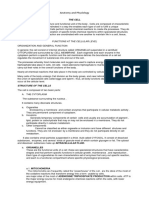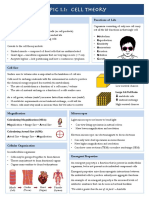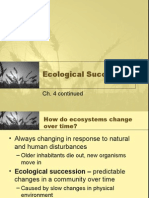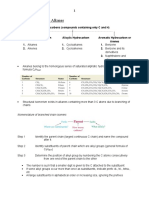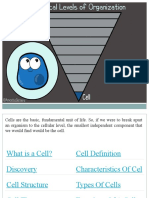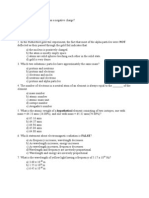Prokaryotic Cells
Prokaryotic Cells
Uploaded by
Berch MelendezCopyright:
Available Formats
Prokaryotic Cells
Prokaryotic Cells
Uploaded by
Berch MelendezOriginal Description:
Copyright
Available Formats
Share this document
Did you find this document useful?
Is this content inappropriate?
Copyright:
Available Formats
Prokaryotic Cells
Prokaryotic Cells
Uploaded by
Berch MelendezCopyright:
Available Formats
Prokaryotic Cells
Prokaryotic cells are cells without a nucleus. The DNA in prokaryotic cells is in the cytoplasm
rather than enclosed within a nuclear membrane. Prokaryotic cells are found in single-celled
organisms, such as bacteria. Organisms with prokaryotic cells are called prokaryotes. They
were the first type of organisms to evolve and are still the most common organisms today.
Eukaryotic Cells
Eukaryotic cells are cells that contain a nucleus. Eukaryotic cells are usually larger than
prokaryotic cells, and they are found mainly in multicellular organisms. Organisms with
eukaryotic cells are called eukaryotes, and they range from fungi to people. Eukaryotic cells
also contain other organelles besides the nucleus. An organelle is a structure within the
cytoplasm that performs a specific job in the cell. Organelles called mitochondria, for example,
provide energy to the cell, and organelles called vacuoles store substances in the cell.
Organelles allow eukaryotic cells to carry out more functions than prokaryotic cells can. This
allows eukaryotic cells to have greater cell specificity than prokaryotic cells. Ribosomes, the
organelle where proteins are made, are the only organelles in prokaryotic cells.
Parts of a typical eukaryotic cell and their function
The plasma membrane is made of phospholipids and protein and serves as the selective
boundary of the cell.
The nucleus is surrounded by a nuclear envelope with nuclear pores. The nucleus stores and
protects the DNA of the cell.
The endomembrane system consists of the endoplasmic reticulum, the Golgi apparatus, and
vesicles. It makes lipids, membrane proteins, and exported proteins and then addresses them and
ships them where they need to go.
Mitochondria are surrounded by two membranes and have their own DNA and ribosomes. They
transfer energy from food molecules to ATP.
Chloroplasts are surrounded by two membranes, contain thylakoids, and have their own DNA
and protein. They transform energy from the sun and CO2 from atmosphere into food molecules
(sugars).
The cytoskeleton is a network of proteins: actin microfilaments, microtubules, and intermediate
filaments. Cytoskeletal proteins support the structure of the cell, help with cell division, and control
cellular movements.
You might also like
- 2009 BAR Q and A Mercantile LawDocument17 pages2009 BAR Q and A Mercantile LawBerch MelendezNo ratings yet
- Activity Design Brgy 1Document1 pageActivity Design Brgy 1Berch Melendez100% (8)
- Nervous System WorksheetDocument2 pagesNervous System WorksheetMcLargoNo ratings yet
- Zoology OutlineDocument3 pagesZoology OutlineEj AgsaldaNo ratings yet
- BIO 361 - SBU Fall 2013 - Exam 1, Lectures 1 - 13Document40 pagesBIO 361 - SBU Fall 2013 - Exam 1, Lectures 1 - 13Nerdy Notes Inc.100% (1)
- Tissues Chapter NotesDocument19 pagesTissues Chapter NotesGagan Deep100% (2)
- Anatomy and Physiology: The CellDocument8 pagesAnatomy and Physiology: The Celllourd nabNo ratings yet
- Prokaryotes and EukaryotesDocument6 pagesProkaryotes and Eukaryoteshussainm1234No ratings yet
- How Did Cell Theory DevelopedDocument4 pagesHow Did Cell Theory DevelopedLourence BajariasNo ratings yet
- Plant TissuesDocument11 pagesPlant TissuesRudra Patel100% (1)
- 1.1 Cell TheoryDocument1 page1.1 Cell TheoryLucca PiaggioNo ratings yet
- BiosphereDocument27 pagesBiosphereJamaika Sofia LetimNo ratings yet
- Female Reproduction Female Reproductive Parts and Functions II. Oogenesis and OvulationDocument4 pagesFemale Reproduction Female Reproductive Parts and Functions II. Oogenesis and OvulationLana GalloNo ratings yet
- Edenton Mission College, Inc.: PhotosynthesisDocument1 pageEdenton Mission College, Inc.: PhotosynthesisLae DeeNo ratings yet
- Excretory System PresentationDocument12 pagesExcretory System Presentationapi-263389150No ratings yet
- Blue and Pink Modern Technology Keynote Presentation PDFDocument13 pagesBlue and Pink Modern Technology Keynote Presentation PDFHana AdivaNo ratings yet
- Animal KingdomDocument1 pageAnimal KingdomWilma VillanuevaNo ratings yet
- Art and ScienceDocument1 pageArt and ScienceAshley AquinoNo ratings yet
- The Periodic Table Webquest AnswersDocument4 pagesThe Periodic Table Webquest AnswersshaneearlNo ratings yet
- Deontological Approach: Dr. Ching Wa Wong City University of Hong Kong Saching@cityu - Edu.hkDocument42 pagesDeontological Approach: Dr. Ching Wa Wong City University of Hong Kong Saching@cityu - Edu.hkPriyanka Jayanth Dube100% (1)
- HydrosphereDocument11 pagesHydrosphereFrancisco de la FlorNo ratings yet
- The Frog and Its External AnatomyDocument1 pageThe Frog and Its External AnatomyDylan Francesca G YuloNo ratings yet
- Ecological SuccessionDocument16 pagesEcological Successionncl12142No ratings yet
- Biography Ni PepeDocument19 pagesBiography Ni PepeAav CanlasNo ratings yet
- Cell Cycle RegulationDocument23 pagesCell Cycle RegulationShikhaj ArmaanNo ratings yet
- Alkyne - Organic ChemistryDocument9 pagesAlkyne - Organic ChemistryHazhir IsmaelNo ratings yet
- Alkanes Notes and Naming PDFDocument4 pagesAlkanes Notes and Naming PDFyad e baiza nawalNo ratings yet
- Nano TechnologyDocument12 pagesNano Technologyrenuka mulaNo ratings yet
- Activity 13Document13 pagesActivity 13Lielannie CarasiNo ratings yet
- Activity 11 STS Climate Change Global Warming Greenhouse EffectDocument1 pageActivity 11 STS Climate Change Global Warming Greenhouse EffectJosiah Samuel Espana0% (1)
- Cell and Molecular Biology20304105Document8 pagesCell and Molecular Biology20304105مروة صلاحNo ratings yet
- Quantum NumbersDocument1 pageQuantum Numbersindian2011No ratings yet
- Organisation of The Organism (Multiple Choice) 1 QPDocument16 pagesOrganisation of The Organism (Multiple Choice) 1 QPforyourhonour wongNo ratings yet
- Cell Cycle and MitosisDocument49 pagesCell Cycle and Mitosishazharomar958No ratings yet
- BIO 310 Midterm 1 PackageDocument28 pagesBIO 310 Midterm 1 PackageNerdy Notes Inc.100% (1)
- Unit 5 (The Fundamental Unit of Life) : Multiple Choice Questions (MCQS)Document22 pagesUnit 5 (The Fundamental Unit of Life) : Multiple Choice Questions (MCQS)Nikhil SahuNo ratings yet
- Atomic Mass and Avogadro's Numberworked - Examples PDFDocument27 pagesAtomic Mass and Avogadro's Numberworked - Examples PDFالغزيزال الحسن EL GHZIZAL HassaneNo ratings yet
- Tissues NotesDocument7 pagesTissues Noteskapil100% (1)
- Cell+ +Cell+MembraneDocument26 pagesCell+ +Cell+Membraneemancipation1506No ratings yet
- Organic Chemistry - Alkanes: Hydrocarbons (Compounds Containing Only C and H)Document6 pagesOrganic Chemistry - Alkanes: Hydrocarbons (Compounds Containing Only C and H)Jojo LeongNo ratings yet
- Quantum Numbers Structure 2Document22 pagesQuantum Numbers Structure 2vishalsingh1997No ratings yet
- Cell Reproduction: How Does It Happen?Document63 pagesCell Reproduction: How Does It Happen?Gabriel NonanNo ratings yet
- Genetics Practice TestDocument6 pagesGenetics Practice TestGirma AlemarNo ratings yet
- CellDocument15 pagesCellprakash kushwahaNo ratings yet
- Temperature Homeostasis (Thermoregulation)Document7 pagesTemperature Homeostasis (Thermoregulation)Fadilah Cuinta FisikaNo ratings yet
- The Cell Cycle and How Cells DivideDocument63 pagesThe Cell Cycle and How Cells DivideSrikanth KagithojuNo ratings yet
- Chemistry Quizs On Qunatm MechanicsDocument6 pagesChemistry Quizs On Qunatm Mechanics06201K0129No ratings yet
- Stem Cells in HumansDocument4 pagesStem Cells in HumansSana NainaNo ratings yet
- Activity 7 - Cell Cycle & Cell Division PDFDocument3 pagesActivity 7 - Cell Cycle & Cell Division PDFKiro ZeroNo ratings yet
- AtmosphereDocument20 pagesAtmosphereCosmin DorgoNo ratings yet
- Cilia and FlagellaDocument25 pagesCilia and FlagellaLia Savitri RomdaniNo ratings yet
- Functions of A CellDocument4 pagesFunctions of A CellyayayanizaNo ratings yet
- Humans and The Microbial WorldDocument41 pagesHumans and The Microbial WorldLudyNo ratings yet
- Cell Division Lab ReportDocument9 pagesCell Division Lab ReportBrianNo ratings yet
- Cell DefinitionDocument2 pagesCell DefinitionjudyNo ratings yet
- 3.2 Names and Formulas of Ionic CompoundsDocument5 pages3.2 Names and Formulas of Ionic CompoundsKen WuNo ratings yet
- Chapter 3 The Molecules of CellsDocument5 pagesChapter 3 The Molecules of Cellsmzunl25476No ratings yet
- Study Guide For Cell Theory TestDocument2 pagesStudy Guide For Cell Theory Testchaine1No ratings yet
- Lithosphere: Tectonic Plates Atmosphere Hydrosphere Biosphere Pedosphere Asthenosphere Lithosphere-Asthenosphere BoundaryDocument42 pagesLithosphere: Tectonic Plates Atmosphere Hydrosphere Biosphere Pedosphere Asthenosphere Lithosphere-Asthenosphere BoundaryKatrina EsguerraNo ratings yet
- Cell OrganizationDocument6 pagesCell OrganizationKaarthigan RamaiahNo ratings yet
- Human Cell, Feb. 2012.Document3 pagesHuman Cell, Feb. 2012.Nina UrakovićNo ratings yet
- Two Types of Cells Prokaryotic Cellseukaryotic CellsDocument2 pagesTwo Types of Cells Prokaryotic Cellseukaryotic Cellsramcallo7No ratings yet
- May 22,2019Document117 pagesMay 22,2019Berch MelendezNo ratings yet
- Cash Book: Cash Book City Economic Ent, Dev.& MNGMTN Office (Ceedmo)Document1 pageCash Book: Cash Book City Economic Ent, Dev.& MNGMTN Office (Ceedmo)Berch MelendezNo ratings yet
- Chapter 2 Summary DRRDocument4 pagesChapter 2 Summary DRRBerch MelendezNo ratings yet
- DRRRDocument2 pagesDRRRBerch MelendezNo ratings yet
- Product Unit Sales and Issuance - Maquewa JULY2013Document2 pagesProduct Unit Sales and Issuance - Maquewa JULY2013Berch MelendezNo ratings yet
- BirDocument1 pageBirBerch MelendezNo ratings yet
- Lemongrab (Research)Document1 pageLemongrab (Research)Berch MelendezNo ratings yet
- Monthly Monitoring 2012Document5 pagesMonthly Monitoring 2012Berch MelendezNo ratings yet
- ScrapDocument5 pagesScrapBerch MelendezNo ratings yet
- Melendez Boarding HouseDocument1 pageMelendez Boarding HouseBerch MelendezNo ratings yet
- Nov. PresentationDocument9 pagesNov. PresentationBerch MelendezNo ratings yet
- G.R. No. 169752 September 25, 2007 Facts:: PSPCA Vs Commission On AuditDocument11 pagesG.R. No. 169752 September 25, 2007 Facts:: PSPCA Vs Commission On AuditBerch MelendezNo ratings yet
- Maquewa Team: ProductDocument9 pagesMaquewa Team: ProductBerch MelendezNo ratings yet
- Product Unit Sales and Issuance - Maramag: Express Card RCBC Loading RTA SNSDocument16 pagesProduct Unit Sales and Issuance - Maramag: Express Card RCBC Loading RTA SNSBerch MelendezNo ratings yet
- Product Unit Sales and Issuance - Maquewa OCTOBER 2012Document2 pagesProduct Unit Sales and Issuance - Maquewa OCTOBER 2012Berch MelendezNo ratings yet
- Activity DesignasdDocument1 pageActivity DesignasdBerch MelendezNo ratings yet
- Tel #. (088) 221-2231, Telefax # (088) 221-4281Document1 pageTel #. (088) 221-2231, Telefax # (088) 221-4281Berch MelendezNo ratings yet
- CorpoDocument2 pagesCorpoBerch MelendezNo ratings yet
- Certification: Nikko L. MelendezDocument1 pageCertification: Nikko L. MelendezBerch MelendezNo ratings yet
- Employee - Any Person Who Performs Services For An Employer in Which Either or Both MentalDocument3 pagesEmployee - Any Person Who Performs Services For An Employer in Which Either or Both MentalBerch MelendezNo ratings yet
- Cases Castillo Vs BalinghasayDocument4 pagesCases Castillo Vs BalinghasayBerch Melendez100% (1)
- Rural Bank of Lipa City Vs CA Case DigestDocument5 pagesRural Bank of Lipa City Vs CA Case DigestBerch Melendez100% (1)
- MC Engineering, Inc., Petitioner, vs. The Court of Appeals, Gerent Builders, Inc. and Stronghold Insurance Co., INC., RespondentsDocument21 pagesMC Engineering, Inc., Petitioner, vs. The Court of Appeals, Gerent Builders, Inc. and Stronghold Insurance Co., INC., RespondentsBerch MelendezNo ratings yet
- Sss Vs Coa 2002Document1 pageSss Vs Coa 2002Berch MelendezNo ratings yet
- RESUME - DeocampoDocument1 pageRESUME - DeocampoBerch MelendezNo ratings yet






